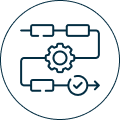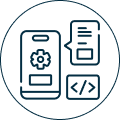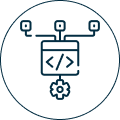ServiceNow Customization and Development
ServiceNow Customization and Development Services involve tailoring the platform to meet specific business needs, including creating custom workflows, applications, and integrations.
Customization and Development
ServiceNow Customization and Development Services involve tailoring the platform to meet specific business needs, including creating custom workflows, applications, and integrations. While ServiceNow offers robust out-of-the-box (OOTB) functionality, customization ensures it aligns seamlessly with unique organizational requirements.

Scope of ServiceNow Customization and Development

Workflow and Process Automation
- Custom Workflows: Automate complex business processes with tailored workflows.
- Approvals and Notifications: Design multi-step approval chains and notification triggers.
- Scripting: Use ServiceNow's scripting capabilities (e.g., Business Rules, Script Includes) for dynamic logic.

Custom Application Development
- Scoped Applications: Develop applications in isolated environments to avoid interference with existing functionality.
- Custom Modules: Extend existing modules or create new ones for specific use cases.
- Low-Code Development: Utilize App Engine Studio for rapid application prototyping and deployment.

User Interface Customization
- Service Portals: Build user-friendly portals with custom branding, themes, and widgets.
- Forms and Dashboards: Modify forms, reports, and dashboards to suit end-user preferences.
- Mobile Customization: Develop mobile-friendly interfaces for on-the-go access.

Integration Development
- Third-Party Systems: Connect ServiceNow with external systems like Salesforce, SAP, Workday, and Jira.
- APIs and Webhooks: Use REST/SOAP APIs and webhooks for seamless data exchange.
- Middleware Solutions: Leverage tools like MuleSoft or Dell Boomi for complex integrations.

Data and Reporting Customization
- Custom Reports: Create tailored reports and dashboards for actionable insights.
- Data Imports: Develop custom scripts to import and manipulate external data.
- Performance Analytics: Build key performance indicator (KPI) dashboards.

Security and Access
- Role-Based Access Controls (RBAC): Define granular access permissions for users and groups.
- Encryption and Compliance: Customize security settings to meet specific compliance requirements (e.g., GDPR, HIPAA).

Advanced Scripting
- Client Scripts: Customize form behaviour in the browser.
- Server-Side Scripts: Handle backend logic for database operations.
- UI Policies and Actions: Dynamically control form elements based on conditions.
- Scripted REST APIs: Create APIs for advanced integration use cases.
ServiceNow Scripting Options

Client-Side Scripts
- Examples: Client Scripts, UI Policies.
- Purpose: Enhance the user interface, validate input, and modify forms dynamically.

Server-Side Scripts
- Examples: Business Rules, Script Includes.
- Purpose: Handle logic, calculations, and database operations.

Integration Scripts
- Examples: Scripted REST APIs, MID Server scripts.
- Purpose: Enable communication with external systems.
Best Practices for Customization and Development

Leverage OOTB Features: Avoid unnecessary customizations to simplify future upgrades.

Follow Scoped App Standards: Use scoped applications for all custom developments to isolate changes.

Write Maintainable Code: Adhere to ServiceNow coding standards and document scripts thoroughly.

Test Rigorously: Conduct unit, regression, and user acceptance testing to ensure functionality.

Plan for Upgrades: Ensure customizations are compatible with ServiceNow’s biannual updates.

Engage Stakeholders: Involve end-users and business leaders in design and testing phases.
Common Use Cases for ServiceNow Customization

Automating IT Asset Management (ITAM): Track and manage complex asset lifecycles.

Enhancing HR Workflows: Tailor HR service delivery processes, such as onboarding.

Optimizing Customer Support: Customize CSM modules for better client engagement.

Custom Notifications: Set up unique alert systems for specific conditions.
Tools for Development

Studio IDE: ServiceNow’s integrated development environment for scripting and application creation.

App Engine Studio: A low-code platform for building and deploying applications quickly.

Integration Hub: For creating integrations using prebuilt connectors and flow templates.
Challenges in Customization and Development
| Challenge | Solution |
| Excessive Customization | Prioritize OOTB features to maintain upgradability. |
| Performance Issues | Optimize scripts and workflows to minimize load times. |
| Upgrade Compatibility | Test customizations against new platform releases. |
| Skills Gap | Leverage certified ServiceNow developers for complex tasks. |
Benefits of Professional ServiceNow Customization
Tailored Fit: Align ServiceNow with unique business requirements.
Increased Efficiency: Automate workflows to save time and resources.
Enhanced User Experience: Provide intuitive interfaces and seamless processes.
Scalability: Build solutions that adapt to future needs.
Customer Testimonials
Your ServiceNow Partner
CtrlAltNow is a niche ServiceNow only consulting company with over 5+ decades of consulting experience and 70+ ServiceNow Product line certifications. Our aim is to challenge the status quo and accelerate the business outcomes.
Workflows with ServiceNow
Businesses across the globe need a smarter workflow solution. ServiceNow offers a strong foundation for all digital workflows connecting people, functions, and systems across your organization. CtrlAltNow is best equipped to partner with business to deliver the ServiceNow workflow solutions.
Our Implementation Success
With over 100+ successful ServiceNow implementations across various ServiceNow products, CtrlAltNow brings in unique set of accelerators to deliver projects on time and with highest quality.
Our ServiceNow Expertise
CtrlAltNow is a ServiceNow focused company and helping clients drive business outcomes with the ServiceNow ITx suite. Our expertise spans from initial scoping and planning, to implementation, to long-term growth and maturity.
Our Operating Philosophy
Our operating philosophy is simple – build high competency team and take up the most challenging assignments. We aspire to build a company where the best ServiceNow talent wants to partner.

